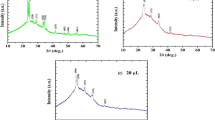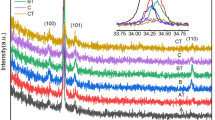Abstract
Owing to the diverse potential applications of hybrid silica–titania thin films, the synthesis and characterization of these films have been carried out with a special focus on application as a medium index layer for multilayered functional coatings. For synthesis, tetraethylorthosilicate and titanium tetraisopropoxide were chosen as precursors for the formation of silica-titania hybrid thin films/nano-composites through an in situ sol–gel process. These films were sequentially obtained on Cu substrate utilizing spin coating. The hybrids were characterized by field emission scanning electron microscope, energy-dispersive X-ray spectroscopy (EDX), X-ray diffraction, atomic force microscopy and Fourier transform infrared spectroscopy (FTIR). Field emission scanning electron microscope morphology displayed a smooth, densified and crack- free layer of silica-titania hybrid nanoparticles in the range of 20–71 nm after calcinations at low temperature of 300ºC for 1 h. X-ray diffraction pattern confirms the phases of titania with higher crystallinity and phase transformation at low temperature. The prepared films were uniform with low 8.852 nm RMS value. The stoichiometry of films was confirmed by EDX results. The FTIR spectroscopy indicated the establishment of heterogeneous chemical bonding between the Ti and Si surfaces through oxygen.






Similar content being viewed by others
References
Mammeri F, Bourhis EL, Rozesa L, Sanchez C (2005) Mechanical properties of hybrid organic–inorganic materials. J Mater Chem 15:3787
Vicente GS, Morales A, Gutierrez MT (2002) Sol–gel TiO2 antireflective films for textured monocrystalline silicon solar cells. Thin Solid Films 403(404):335
Frenzer G, Maier WF (2006) Amorphous porous mixed oxides: sol–gel ways to a highly versatile class of materials and catalysts. Annu Rev Mater Res 36:281
Bokobza L, Diop AL (2010) Reinforcement of poly (dimethylsiloxane) by sol–gel in situgenerated silica and titania particles. Express Polym Lett 4:355
Mccarthy DW, Marks JE, Clarson SJ, Schaefer DW (1998) Synthesis, structure, and properties of hybrid organic–inorganic composites based on polysiloxanes. II. Comparisons between poly (methylphenylsiloxane) and poly (dimethylsiloxane), and between titania and silica. J Polym Sci B Poly Phys 36:1191
Wang F, Luo Z, Qing S, Qiu Q, Li R (2009) Sol-gel derived hybrid thin films with high refrective index. J Alloys Compd 486:521
Hinczewskia DS, Hinczewskib M, Tepehana FZ, Tepehana GG (2005) Optical filters from SiO2 and TiO2 multi-layers using sol–gel spin coating method. Sol Energy Mater Sol Cells 87:181
Zhang KY, Boisjolly G, Rivory J, Kilian L, Colliex C (1994) Characterization of TiO2/SiO2 multilayers by high resolution transmission electron microscopy and electron energy loss spectroscopy. Thin Solid Films 253:299
Brinley E, Seal S, Folks R, Braunstein E, Kramer L, Seal S (2006) High efficiency SiO2–TiO2 hybrid sol–gel antireflective coating. J Vac Sci Technol A 24:1141
Klein LC (1994) Sol–gel optics processing and applications. Kluwer Publications, Berlin
Wang L, Tian Y, Ding H, Li J (2006) Microstructure and properties of organosoluble polyimide/silica hybrid films. Eur Polym J 42:2921
Karthikeyan A, Almeida RM (2000) Crystallization of SiO2–TiO2 glassy films studied by atomic force microscopy. J Non Cryst Solids 274:169
Maeda M, Yamasaki S (2005) Effect of silica addition on crystallinity and photo-induced hydrophilicity of titania–silica mixed films prepared by sol–gel process. Thin Solid Films 483:102
Brusatin G, Guglielmi M, Innocenzi P, Martucci A, Battaglin G, Pelli S, Righini G (1997) Microstructural and optical properties of sol-gel silica–titania waveguides. J Non Cryst Solids 220:202
Alem A, Sarpoolaky H, Keshmiri M (2009) Sol–gel preparation of titania multilayer membrane for photocatalytic applications. Ceram Int 35:1837
Anand VK, Sood SC, Sharma A (2010) Characterization of ZnO thin film deposited by sol–gel process. International conference on methods and models in science and technology. 399–401
Crisan M, Ileanu MR, Preda S, Zaharescu M, Valean AM, Popovici EJ, Teodorescu VS, Matejec V, Mrazek J (2006) Manganese doped sol–gel materials with catalytic properties. J Optoelectron Adv Mater 8(2):815
Thim GP, Oliveira MAS, Oliveira EDA, Melo FCL (2000) Sol–gel silica film preparation from aqueous solutions for corrosion protection. J Non Cryst Solids 273:124
Xiaoan F, Qutubuddin S (2001) Synthesis of titania-coated silica nanoparticles using a nonionic water-in-oil micro emulsion. Colloids Surf 179:65
Asghar M, Placido F, Naseem S (2007) Multilayer complex optical filters prepared by reactive evaporation. Opt Eng 42(6):023802
Shuxi D, Yanqiang W, Toshio S, Zuliang D, Hideki S, Masahiko A (2010) Preparation of highly crystalline TiO2 nanostructures by acid-assisted hydrothermal treatment of hexagonal-structured nanocrystalline titania/cetyltrimethyammonium bromide nano skeleton. Nanoscale Res Lett 5:1829
Gopinathan C, Kavitha M, Pandi P (2013) Optical properties of (AR) multilayer thin film for solar cell application. IOSR J Appl Chem 4(4):01
Aaritalo V, Meretoja V, Teemu T, Sami A, Jamsa T, Tuukkanen J, Rosling A, Narhi T (2010) Development of a low temperature sol–gel-derived titania-silica implant coating. Mater Sci Appl 1:118
Shokuhfar A, Alzamani M, Eghdam E, Karimi M, Mastali S (2012) SiO2–TiO2 nanostructure films on windshields prepared by sol–gel dip-coating technique for self-cleaning and photocatalytic applications. Nanosci Nanotechnol 2(1):16
Que W, Jia CY, Sun M, Cheng L, Wang LL, Zhang ZJ, Sun Z (2008) GeO2/organically modified silane sol–gel hybrid organic–inorganic films for photonic applications. 2nd IEEE international nanoelectronics conference 176–181
Hasegawa I, Nakamura T, Kajiwara M (1996) Synthesis of continuous silicon carbide titanium carbide hybrid fibers through sol–gel processing. Mater Res Bull 31:869
Hilonga A, Kim JK, Sarawade PB, Kim HT (2010) Rapid synthesis of homogeneous titania-silica composite with high-BET surface area. Powder Technol 199:288
Lorret O, Lafond V, Mutin PH, Vioux A (2006) One-step synthesis of mesoporous hybrid titania-silica xerogels for the epoxidation of alkenes. Chem Mater 18:4707
Ding B, Kim H, Kim C, Khil M, Park S (2003) Morphology and crystalline phase study of electro spun TiO2–SiO2 nanofibres. Nanotechnology 14:532
Chien WC, Yu YY, Chen PK, Yu HH (2011) Microwave-assisted synthesis and characterization of poly(acrylic)/SiO2–TiO2 core–shell nanoparticle hybrid thin films. Thin Solid Films 519:5274
Seco AM, Goncalves MC, Almeida RM (2000) Densification of hybrid silica–titania sol–gel films studied by ellipsometry and FTIR. Mater Sci Eng B 76:193
Que W, Sun Z, Lam YL, Chan YC, Kam CH (2001) Effects of titanium content on properties of sol–gel silica–titania films via organically modified silane precursors. J Phys D Appl Phys 34:471
Pickup MD, Mountjoy G, Wallidge WG, Anderson R, Cole MJ, Newport JR, Smith EM (1999) J Mater Chem 9:1299
Yeh JT, Chai WL, Wu CS (2008) Study on the preparation and characterization of biodegradable polylactide/SiO2–TiO2 hybrids. Polym Plast Technol Eng 47:887
Wu CS (2004) In situ polymerization of titanium isopropoxide in polycaprolactone: properties and characterization of the hybrid nanocomposites. J Appl Polym Sci 92:1749
Bertoluzza A, Fagnano C, Morelli MA (2003) Raman and infrared spectra on silica gel evolving toward Glass. J Non Cryst Solids 48(1):117
Acknowledgments
The authors would like to convey their thanks to Advanced Photonic Science Institute, University Technology Malaysia and Centre of Excellence in Solid State Physics, Punjab University for allowing the research and to be undertaken.
Author information
Authors and Affiliations
Corresponding author
Rights and permissions
About this article
Cite this article
Islam, S., Rahman, R.A., Othaman, Z. et al. Preparation and characterization of crack-free sol–gel based SiO2–TiO2 hybrid nanoparticle film. J Sol-Gel Sci Technol 68, 162–168 (2013). https://doi.org/10.1007/s10971-013-3147-x
Received:
Accepted:
Published:
Issue Date:
DOI: https://doi.org/10.1007/s10971-013-3147-x




